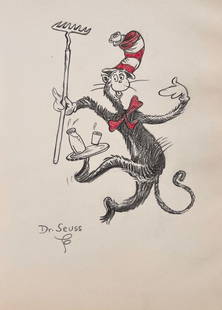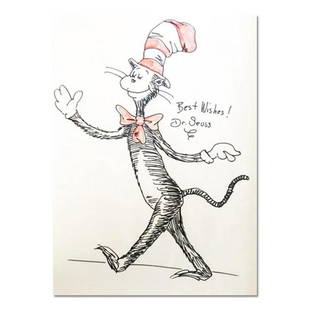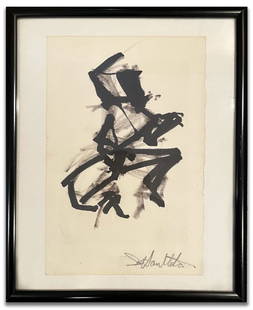
RARE CLEWS 1820s DR SYNTAX DRAWING AFTER NATURE PLT XG
Similar Sale History
View More Items in Drawings
Related Drawings
More Items in Drawings
View MoreRecommended Art
View More








Item Details
Description
We are extremely pleased to present this fine 1820-1825 James & Ralph Clews plate in the deep Cobalt transfer Dr. Syntax series. Reproduced later by William Adams, and in America by the legendary Buffalo Pottery, Dr. Syntax items have always been a prime collectible genre. This Drawing After Nature treasure features fashionable gentry watching an artist drawing a horse, cows, pigs, chickens, dog and very friendly white geese. Our exact Dr Syntax Drawing After Nature plate was potted at the Clews, Cobridge, Staffordshire, England Works, and is displayed by Joseph Allen Skinner Museum - DSC07762.JPG. As an interesting historical fact is that the Cobridge Works was rented from William Adams in 1817, but the constant problems & the poor condition of the pottery forced James & Ralph Clews into bankruptcy ca. 1834. Condition notwithstanding, all of the flow blue transfers featured rich deep Cobalt and outstanding definition. Our valuable plate weighs 1# 6 oz. and measures a prominent 10.5 x 10.5 x 1 inch deep, and is in VG+ condition (spectacular condition for a 190 year old potting). Research consulted: Encyclopedia of Marks On American, English, and European Earthenware Ironstone & Stoneware 1780 to 1980 / by Arnold & Dorothy Kowalsky; Encyclopedia of British Pottery and Porcelain Marks, AND, An Illustrated Encyclopedia Of British Pottery And Porcelain 2nd Ed / both by Geoffrey A. Godden. xxxxxxxxxxxx.Ralph and James Clews, born in 1788 and 1790 respectively, were two of the sons of John Clews, a hatter, of Newcastle-under-Lyme, Staffordshire. By 1811, James Clews was acting as clerk to the potter Andrew Stevenson, and he and Ralph were in business on their own by the autumn of 1813, establishing their first pottery at the Bleak Hill Works on Elder Road in Cobridge, near to Burslem. Bleak Hill was a small factory with only two ovens that had been operated by Peter Warburton until his untimely death in January 1813 at the age of 40. An insurance policy which the widow Mary Warburton took out in July 1817 specifies the premises as being in the occupation of Ralph and James Clews and it seems likely that the brothers took the opportunity presented by the empty factory when they first entered business in 1813. In 1817, due to increased demand, the brothers rented a second factory, the Globe Works in Cobridge, and it was at this pottery they developed their enormous export trade to the United States. The Clews brothers continued to occupy the Bleak Hill factory until 1827, when the works was advertised to let and they took out a lease on the Cobridge Works of Andrew Stevenson who had retired from business around that date.The 1827 move from Bleak Hill to the much larger Cobridge Works was clearly intended to provide additional manufacturing capacity, the rent was double that of the nearby Globe Works which they also continued to operate. A major contribution to the growth of Clews’ business was their close relationship with the firm of merchants and importers Bolton, Ogden, & Co., who effectively financed the manufacturers by advancing a proportion of the value of consignments prior to sale. This arrangement resulted in Clews becoming substantially indebted to their importer. When production problems arose, due to industrial unrest in the Potteries in 1834, the business had no reserves to cope with the loss of revenue and the Clews brothers went bankrupt with enormous liabilities and relatively few assets. Bolton, Ogden & Co were owed over £68,000, of which some £35,000 was unsold ware.Following their bankruptcy in 1834 / 35, James Clews moved to America. In 1836 he visited Louisville, Kentucky, where, unaware of his recent bankruptcy, the City offered him almost unlimited backing if he would set up a pottery to make fine earthenware nearby. Clews decided that suitable clay and coal were available at Troy Indiana a few miles down the Ohio River and the Indiana Pottery Co, was established. In late 1836, Clews arranged the importation of thirty six potters, probably from the Staffordshire industry, which at that time was in the throes of a protracted strike. $50, 000 and two years later, a petition by the company to Congress dated 4th January 1838 stated that it was capable of producing Queensware and china but could not do so at a profit without access to the raw materials to be found on public lands. The petition was turned down, and the pottery continued in operation, but James Clews sold his shares in 1842 and moved on. He sailed home with his wife and children in 1841 and sailed back and forth between Britain and North America over the next few years, perhaps finishing up business. By 1851 he was living with his family and servants at Ox Leasows, Stone, in Staffordshire where he passed in 1861.
Condition
Very Good + condition, has general base crazing
Buyer's Premium
- 13% up to $100.00
- 13% up to $10,000.00
- 13% above $10,000.00
RARE CLEWS 1820s DR SYNTAX DRAWING AFTER NATURE PLT XG
Estimate $350 - $425
2 bidders are watching this item.
Shipping & Pickup Options
Item located in SHEFFIELD, AL, usSee Policy for Shipping
Payment

TOP




























![Dr. Seuss, original Life Magazine drawing: Dr. Seuss, original Life Magazine drawing, Dr. Seuss [Theodore Geisel] (American, 1904-1991), "Farmers' Daughter Relief", ink and gouache on illustration board, signed "Dr. Seuss" and inscribed and si](https://p1.liveauctioneers.com/188/265963/138980179_1_x.jpg?height=310&quality=70&version=1666703289)




















![Berthe Morisot - La Lecon de dessin (Berthe Morisot dessinant avec sa fille) (The Drawing Lesson: Artist: Berthe Morisot Title: La Lecon de dessin (Berthe Morisot dessinant avec sa fille) (The Drawing Lesson [Berthe Morisot Drawing with Her Daughter] Year: 1889 Dimensions: 7in. by 5in.</](https://p1.liveauctioneers.com/1537/327838/176636756_1_x.jpg?height=310&quality=70&version=1714166346)






























